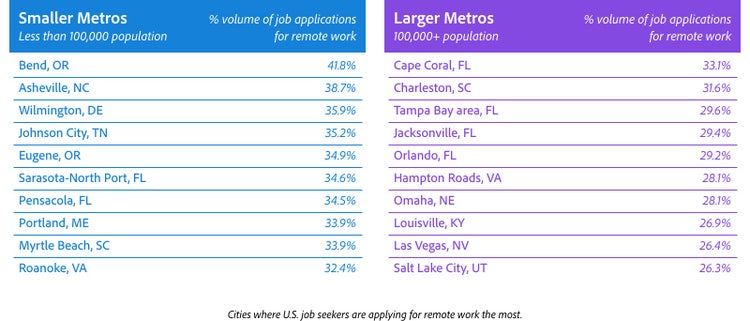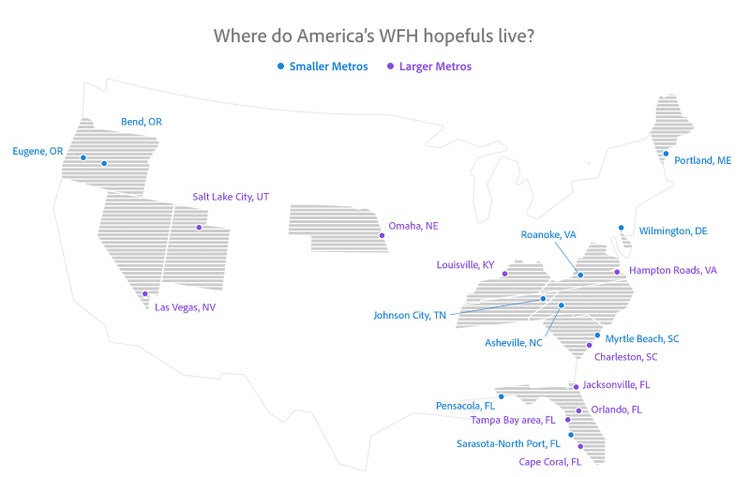Where’s anywhere? Top 20 most popular cities for remote workers

For fairly obvious reasons, remote work has become increasingly prevalent in America over the past couple of years. As professional jobs across the country adapted to socially distanced realities, attitudes toward remote work changed quickly.
Soon, work-from-home evolved to work-from-anywhere, with employees embracing flexibility and balance and seeking opportunities that allowed them to do their jobs outside a traditional office — and, more and more, far away from the organization itself.
In this article
- The growth of remote work
- Remote work hotspots
- Get inspired by those doing it right
- The future of work
The growth of remote work
In two years, remote work opportunities have grown from less than 4 percent of all high-paying jobs — $100,000-plus — before the pandemic to more than 15 percent today. That’s according to data from the career site Ladders, which projects that 25 percent of all high-paying jobs in North America will be remote by the end of 2022 and opportunities will increase further in 2023. In the U.S. between January 2020 and March 2022, job postings that explicitly mentioned remote work increased by 319 percent.
As employees start to return to the office, and while some companies disregard the much-discussed Great Resignation, it seems clear that the way we work has changed forever, and remote — or at least hybrid — work is here to stay. Organizations that fail to redesign their structures and cultures around the modern employee experience do so at their own peril. Talent is fleeing companies that insist on preserving a traditional work environment and flocking to opportunities that prize employee autonomy, choice, and flexibility.
According to Pew Research published in February, nearly 60 percent of U.S. workers who said they had jobs that could be done from home were working from home all or most of the time — and 80 percent of those said they wanted to continue doing so in the future, citing better work-life balance and productivity. A Morning Consult survey found that almost half of Millennials and Gen Z workers would consider quitting their job if their employer didn’t offer remote work flexibility, and in another survey — conducted in May — 79 percent of people said they’d be more likely to apply for a different job that did.
Companies that offer the technological tools and organizational environment to enable such workplace flexibility are positioned to attract the best talent. Today, tens of millions of Americans are working remotely, and many are no longer obligated — or opting — to live in big cities and established financial centers. With so many employees now freed to move and work from almost anywhere, the big question is: where are they living?
Remote work hotspots
According to LinkedIn data, remote work opportunities in August 2021 comprised 30 percent of all applications to paid U.S. job postings. That remote application activity was more than triple the rate of 9.8 percent in August 2020, and it was up nearly 10-fold from the 2.8 percent share of all job applications remote work had in January 2020, before the coronavirus hit. And some areas, in particular, have become meccas for people seeking remote work.
Perhaps not surprisingly, places with warm weather and natural beauty dominated the list of WFH hotspots — the places where applicants were living when they applied to remote jobs. Of the top 10 larger cities (population over 100,000 people), more than half were located in the Sun Belt, with four in Florida alone. Of the 10 smaller cities (population under 100,000), four were in popular outdoor adventure areas, including two of the top five in Oregon.

Smaller Metros (% volume of job applications for remote work)
Less than 100,000 population
- Bend, OR (41.8%)
- Asheville, NC (38.7%)
- Wilmington, DE (35.9%)
- Johnson City, TN (35.2%)
- Eugene, OR (34.9%)
- Sarasota-North Port, FL (34.6%)
- Pensacola, FL (34.5%)
- Portland, ME (33.9%)
- Myrtle Beach, SC (33.9%)
- Roanoke, VA (32.4%)
Larger Metros (% volume of job applications for remote work)
100,000+ population
- Cape Coral, FL (33.1%)
- Charleston, SC (31.6%)
- Tampa Bay area, FL (29.6%)
- Jacksonville, FL (29.4%)
- Orlando, FL (29.2%)
- Hampton Roads, VA (28.1%)
- Omaha, NE (28.1%)
- Louisville, KY (26.9%)
- Las Vegas, NV (26.4%)
- Salt Lake City, UT (26.3%)
Get inspired by those doing it right
There’s a conspicuous lack of the usual big-market job centers — New York City, Chicago, anywhere in California — with remote work-seekers preferring less-crowded, less-expensive alternatives in more far-flung rural areas. Among large metros, San Francisco and New York ranked last — at 16.4 percent each — in residents’ interest in remote work, presumably owing to their high cost of living.
“The pandemic spurred a burst of mobility that is accelerating changes in where and how Americans live,” The Wall Street Journal wrote last year. Partly driven by the promise of flexible, remote work, more than seven million households moved to a different county in 2020, with many leaving large metropolitan areas and migrating toward “less-dense, more-affordable places that offered more space.” Some employees — especially those in the tech industry — are even leaving the U.S. and going abroad to work remotely.

Geo map showing the smaller cities and larger metros with the most remote applications as “hot spots” with circles or other design elements and perhaps some other information.
The future of work
If we’ve answered the question of where remote work applicants are living, a follow-up would be: how are they doing it? The answer is digital tools, technology, applications, and workflows — in addition to a flexible organizational structure and supportive culture — that can enable greater collaboration, efficiency, and productivity.
Digital documents are the backbone of modern business, spanning nearly every organizational function and process. For today’s teams, digital document management tools make remote work not just viable but actually successful — thanks to features like real-time collaboration, application integrations, unlimited compliant e-signatures, mobile functionality, and trusted security.
No matter the role, an all-in-one digital document solution helps employees work better and companies do more business. So, whether you are in Bend, Oregon or Cape Coral, Florida, you can work faster, smarter, and more collaboratively in a remote or hybrid environment with Adobe Document Cloud.